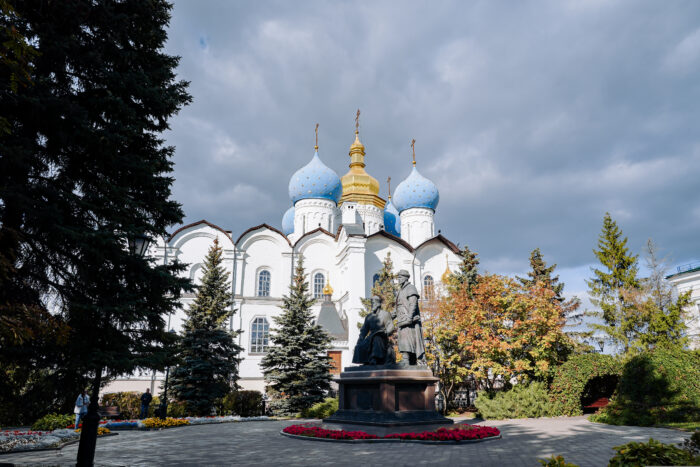Annunciation Cathedral
В 1996-2005 годах под руководством архитекторов Татарского специального научно-реставрационного управления Р.Р. Раимовой и И.Б. Харисовой велись работы по реставрации Благовещенского собора. 19 июля 2005 года собор вновь был освящён архиепископом Казанским Анастасием. 21 июля 2005 года Первую литургию в возрожденном соборе отслужил Патриарх Алексий II.
Информация для посетителей
Режим работы
Благовещенский собор работает ежедневно
с 9:00 – 20:00
В настоящее время Благовещенский собор является действующим православным храмом, открытым для посещения. В подклети храма находится Музей истории Благовещенского собора, открытый для посещения.
Во время посещения собора необходимо надеть платок (для женщины), снять головной убор (для мужчин) закрыть оголенные части тела (плечи, колени), перевести телефон в беззвучный режим. Запрещено фотографировать молящихся, чтецов, лиц, ответственных за проведения религиозных мероприятий. При проведении религиозных мероприятий доступ туристов может быть ограничен.
Описание объекта
Благовещенский собор построен в 1561-1562 годах в северо-восточной части Казанского Кремля псковскими мастерами Постником Яковлевым и Иваном Ширяем на месте небольшой деревянной церкви, созданной по указу Ивана Грозного в 1552 году.
Собор на протяжении своей истории многократно перестраивался, горел в пожарах, реставрировался, а в советский период храм был закрыт, часть архитектурных объектов было разрушено, здание собора использовалось для бытовых нужд. Реставрация собора прошла в 1977-1982 и в 1996-2005 годах.
Благовещенский собор представляет собой строение с 5 главами, 5 апсидами (полукруглый выступ здания, примыкающий к основному объёму) и 2 приделами (часть храма, выделенная для размещения дополнительного алтаря с престолом для богослужений).
Центральный объём сложен из белого камня, опирается на 6 столпов, имеет 4 боковых барабана (цилиндрическая верхняя часть здания, которая венчается куполом) с луковичными завершением и 1 центральный барабан, выполненный в стиле украинского барокко, 3 апсиды и боковые приделы с апсидами. Внутренние столбы в храме круглые, переход к главному куполу оформлен в виде сводчатой конструкции в форме части конуса (тромп), что визуально позволяет перейти от купола к кубическому объёму помещения.
В основном объёме имеется цокольный этаж, стены и крестовые своды которого выложены из тесанных блоков известняка. Цокольный этаж XVI века использовался как отдельный храм Всех Святых.
Фасад здания украшен узорчатыми поясками, соединенными аркатурами (ложные арки). Стены имеют килевидные завершения (полуовал с внешним заострением) и позакомарные (полукруглое завершение стены) покрытия. Боковые луковичные главы голубого цвета украшены позолоченными звёздами, позолоченная центральная глава имеет барочную грушевидную форму.
С южной и северной сторон к центральному объему собора примыкают два кирпичных придела с полукруглыми апсидами; с запада – обширная двухсветная трапезная. Трапезная построена из кирпича, оштукатурена, имеет позакомарное покрытие, фасады декорированы плоскими пилястрами (вертикальный выступ). Трапезная двусветная, по периметру устроены хоры (верхняя открытая галерея) с лестницей у западной стены. Стены храма и трапезной расписаны масляными красками (живопись XIX века).
В 1996-2005 годах под руководством архитекторов Татарского специального научно-реставрационного управления Р.Р. Раимовой и И.Б. Харисовой велись работы по реставрации Благовещенского собора. 19 июля 2005 года собор вновь был освящён архиепископом Казанским Анастасием. 21 июля 2005 года Первую литургию в возрожденном соборе отслужил Патриарх Алексий II.
В настоящее время Благовещенский собор является действующим православным храмом, открытым для посещения. В подклети храма находится Музей истории Благовещенского собора, открытый для посещения.
До настоящего времени не сохранилась колокольня Благовещенского собора, которая была построена в XVII веке по благословению казанского митрополита Матфея. Пятиярусная 50-метровая белокаменная колокольня была видна каждому, кто въезжал на территорию Казанского Кремля. На нижнем ярусе колокольни находился огромный колокол весом 2,5 тонны – самый большой в древней Казани. В XVIII веке на колокольне были часы с боем, а купол изначально имел шлемовидную форму. Колокольня примыкала к крыльцу трапезной части Благовещенского собора. Под колокольней находился храм, первоначально освященный в честь святой мученицы Ирины, но конце XVIII века из-за ветхости он был закрыт. По инициативе архиепископа Казанского Филарета этот храм в 1832 году был восстановлен и освящен во имя казанского чудотворца святого Германа. В советский период колокольня была разрушена. Сейчас на её месте находится сквер.






